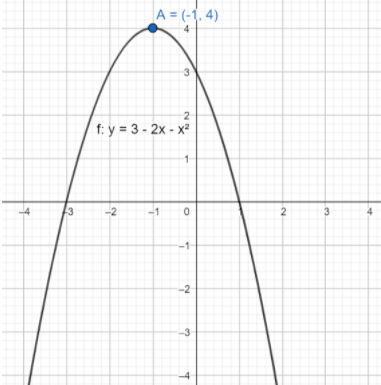
How do you write $y=3-2x-{{x}^{2}}$ in vertex form?
Answer
532.2k+ views
Hint: When we have a quadratic equation which in the form of $y=a{{x}^{2}}+bx+c$, then the vertex from of the equation can be written as $y=a{{\left( x-h \right)}^{2}}+k$ where $\left( h,k \right)$ is the vertex of the parabola. To convert the given equation in the vertex form first we will write the given equation in the form of $y=a{{x}^{2}}+bx+c$ and write the values of $a$, $b$, $c$. Now we will add and subtract the square of half of $b$ i.e., ${{\left( \dfrac{b}{2} \right)}^{2}}$. Now we will use the algebraic formulas either ${{\left( a+b \right)}^{2}}={{a}^{2}}+2ab+{{b}^{2}}$ or ${{\left( a-b \right)}^{2}}={{a}^{2}}-2ab+{{b}^{2}}$ and simplify the equation to get the result.
Complete step by step answer:
Given that, $y=3-2x-{{x}^{2}}$
Rearranging the terms in the above equation to convert the given equation in the form of $y=a{{x}^{2}}+bx+c$.
$y=-{{x}^{2}}-2x+3$
Comparing the above equation with the $y=a{{x}^{2}}+bx+c$, then we will get
$a=-1$, $b=-2$, $c=3$.
Now the value of ${{\left( \dfrac{b}{2} \right)}^{2}}$ is given by
$\begin{align}
& {{\left( \dfrac{b}{2} \right)}^{2}}={{\left( \dfrac{-2}{2} \right)}^{2}} \\
& \Rightarrow {{\left( \dfrac{b}{2} \right)}^{2}}={{\left( -1 \right)}^{2}} \\
& \Rightarrow {{\left( \dfrac{b}{2} \right)}^{2}}=1 \\
\end{align}$
Adding and subtracting the above value from the given equation, then we will get
$y=-{{x}^{2}}-2x+3+1-1+3$
Rearranging the terms in the above equation, then we will have
$y=-{{x}^{2}}-2\left( 1 \right)\left( x \right)-1+1+3$
Taking $-ve$ sign common from the terms $-{{x}^{2}}-2\left( 1 \right)\left( x \right)-1$ in the above equation, then we will get
$y=-\left( {{x}^{2}}+2\left( 1 \right)\left( x \right)+{{1}^{2}} \right)+4$
Using the algebraic formula ${{\left( a+b \right)}^{2}}={{a}^{2}}+2ab+{{b}^{2}}$ in the above equation, then we will get vertex form of the given equation as
$y=-{{\left( x+1 \right)}^{2}}+4$
Comparing the above equation with the vertex form $y=a{{\left( x-h \right)}^{2}}+k$, then we will get
$a=-1$, $-h=1\Rightarrow h=-1$, $k=4$ and the vertex of the parabola is $\left( -1,4 \right)$.
Note: We can check whether the obtained solution is right or wrong. When we draw the graph of the given equation, if we get the vertex of the curve or parabola is the same as the vertex, we have calculated from the vertex form, then our solution is correct. We can see the graph of the given equation in the figure below.

In the above figure we can observe that the vertex as the curve is $A\left( -1,4 \right)$ which is the same as the vertex from the vertex form $\left( -1,4 \right)$. So, our answer is correct.
Complete step by step answer:
Given that, $y=3-2x-{{x}^{2}}$
Rearranging the terms in the above equation to convert the given equation in the form of $y=a{{x}^{2}}+bx+c$.
$y=-{{x}^{2}}-2x+3$
Comparing the above equation with the $y=a{{x}^{2}}+bx+c$, then we will get
$a=-1$, $b=-2$, $c=3$.
Now the value of ${{\left( \dfrac{b}{2} \right)}^{2}}$ is given by
$\begin{align}
& {{\left( \dfrac{b}{2} \right)}^{2}}={{\left( \dfrac{-2}{2} \right)}^{2}} \\
& \Rightarrow {{\left( \dfrac{b}{2} \right)}^{2}}={{\left( -1 \right)}^{2}} \\
& \Rightarrow {{\left( \dfrac{b}{2} \right)}^{2}}=1 \\
\end{align}$
Adding and subtracting the above value from the given equation, then we will get
$y=-{{x}^{2}}-2x+3+1-1+3$
Rearranging the terms in the above equation, then we will have
$y=-{{x}^{2}}-2\left( 1 \right)\left( x \right)-1+1+3$
Taking $-ve$ sign common from the terms $-{{x}^{2}}-2\left( 1 \right)\left( x \right)-1$ in the above equation, then we will get
$y=-\left( {{x}^{2}}+2\left( 1 \right)\left( x \right)+{{1}^{2}} \right)+4$
Using the algebraic formula ${{\left( a+b \right)}^{2}}={{a}^{2}}+2ab+{{b}^{2}}$ in the above equation, then we will get vertex form of the given equation as
$y=-{{\left( x+1 \right)}^{2}}+4$
Comparing the above equation with the vertex form $y=a{{\left( x-h \right)}^{2}}+k$, then we will get
$a=-1$, $-h=1\Rightarrow h=-1$, $k=4$ and the vertex of the parabola is $\left( -1,4 \right)$.
Note: We can check whether the obtained solution is right or wrong. When we draw the graph of the given equation, if we get the vertex of the curve or parabola is the same as the vertex, we have calculated from the vertex form, then our solution is correct. We can see the graph of the given equation in the figure below.

In the above figure we can observe that the vertex as the curve is $A\left( -1,4 \right)$ which is the same as the vertex from the vertex form $\left( -1,4 \right)$. So, our answer is correct.
Recently Updated Pages
Two men on either side of the cliff 90m height observe class 10 maths CBSE

What happens to glucose which enters nephron along class 10 biology CBSE

Cutting of the Chinese melon means A The business and class 10 social science CBSE

Write a dialogue with at least ten utterances between class 10 english CBSE

Show an aquatic food chain using the following organisms class 10 biology CBSE

A circle is inscribed in an equilateral triangle and class 10 maths CBSE

Trending doubts
Why is there a time difference of about 5 hours between class 10 social science CBSE

Write a letter to the principal requesting him to grant class 10 english CBSE

What is the median of the first 10 natural numbers class 10 maths CBSE

The Equation xxx + 2 is Satisfied when x is Equal to Class 10 Maths

Which of the following does not have a fundamental class 10 physics CBSE

State and prove converse of BPT Basic Proportionality class 10 maths CBSE




